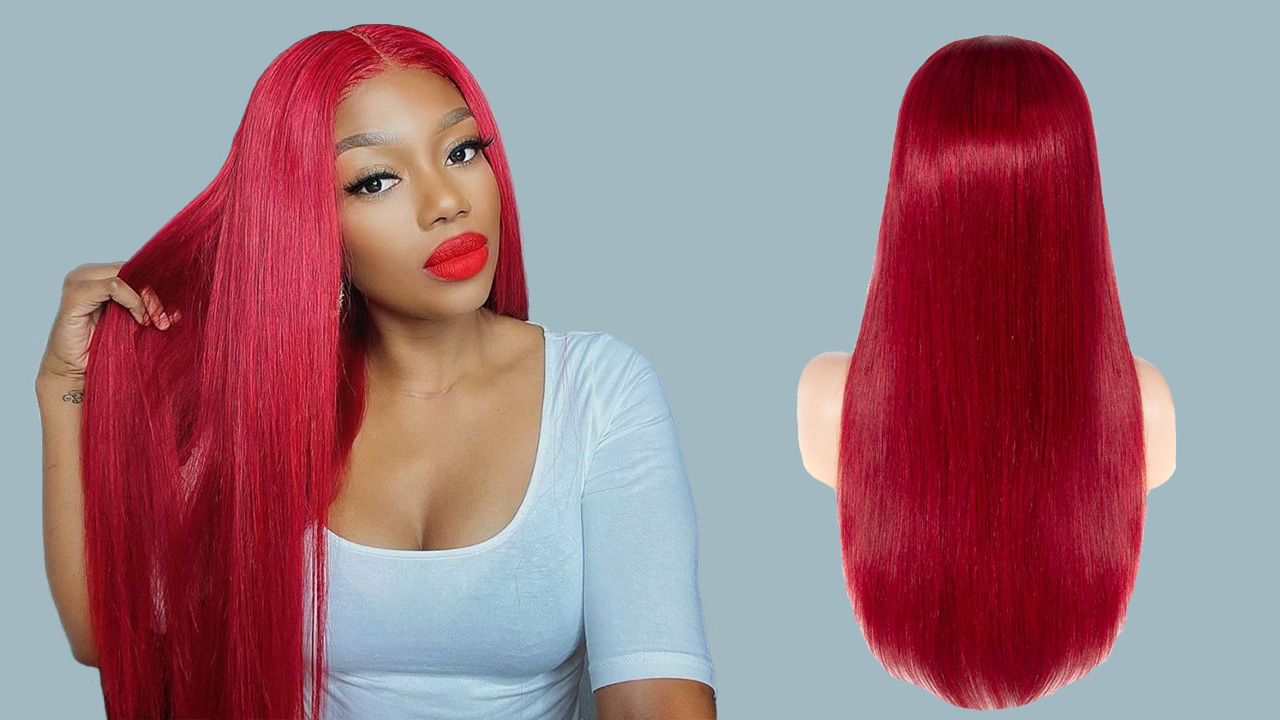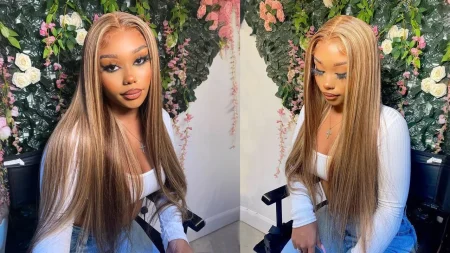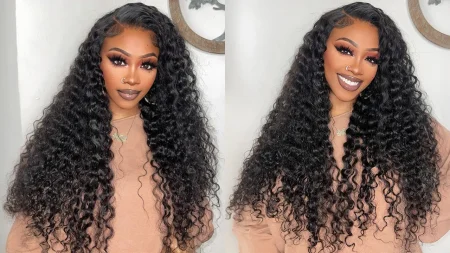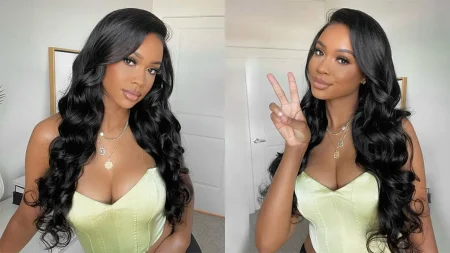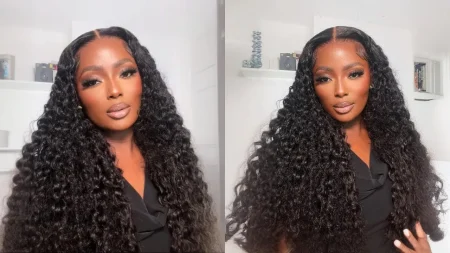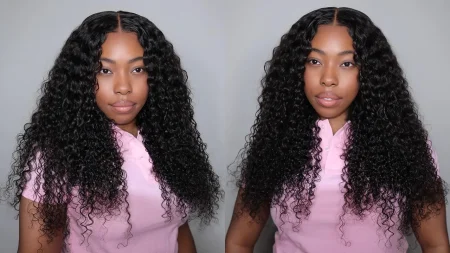Red color lace wigs have gained immense popularity for their vibrant and eye-catching appeal. However, choosing the perfect red lace wig can be a daunting task, given the array of options available. In this comprehensive guide, we will walk you through the essential factors to consider when selecting a suitable red color lace wig that complements your style, personality, and complexion.

1. Determine your red shade.
Before diving into the world of red lace wigs, it’s crucial to decide which shade of red you want. The spectrum of reds is vast, ranging from deep burgundies and cherry reds to fiery oranges and vibrant scarlets. Your choice should align with your personal style and preferences. Here are a few popular red shades to consider:
a. Burgundy red.
Burgundy red is a rich and dark hue that exudes elegance and sophistication. It’s an excellent choice for those who prefer a more subdued red color that can be versatile for both formal and casual occasions.
b. Cherry red.
Cherry red is a vibrant and playful shade that adds a pop of color to your appearance. This shade is perfect for individuals looking to make a bold statement and showcase their adventurous side.
c. Auburn red.
Auburn red combines red and brown undertones, creating a warm and natural-looking shade. It’s an ideal choice for those who want a red hue that isn’t too overpowering and complements various skin tones.
d. Copper red.
Copper red has orange undertones, creating a fiery and eye-catching look. This shade is perfect for individuals who want to stand out and embrace a unique, unconventional color.
e. Scarlet red.
Scarlet red is a classic and intense red shade that commands attention. It’s a great choice for those who want a timeless and bold appearance.
Once you’ve identified your preferred red shade, you can narrow down your options and focus on finding wigs that match your desired color.
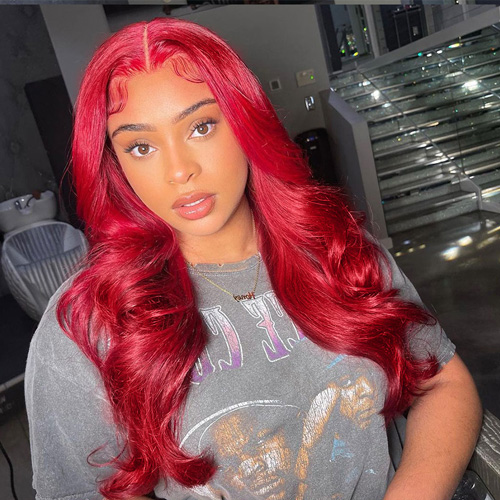
2. Choose the right wig type.
Red color lace wigs come in various types, each offering distinct benefits and aesthetics. The choice of wig type largely depends on your personal preferences, comfort, and styling needs. Here are some common wig types to consider:
a. Human hair lace wigs.
Human hair lace wigs are renowned for their natural appearance and versatility. They can be styled, dyed, and treated just like your own hair. If you’re seeking a red lace wig with the highest level of realism and quality, human hair wigs are the way to go. They also provide superior comfort and breathability.
b. Synthetic lace wigs.
Synthetic lace wigs are more affordable than human hair wigs and come in a wide range of colors, including various shades of red. They require less maintenance and are pre-styled, making them convenient for those with a busy lifestyle. However, they may have a slightly less natural look and limited heat resistance.
c. Blended lace wigs.
Blended lace wigs combine both human hair and synthetic fibers, offering a balance between realism and affordability. These wigs often provide the best of both worlds and can be a suitable choice if you’re looking for a red lace wig with a reasonable price point.
d. 360 lace wigs vs. lace front wigs.
Consider whether you want a 360 lace wig or a lace front wig. 360 lace wigs have lace material covering the entire cap, allowing for versatile parting and styling options. Lace front wigs have lace only at the front, which creates a natural hairline but limits parting options. Choose based on your styling preferences.
3. Determine the wig length.
The length of your red lace wig plays a significant role in your overall look. Consider the following factors when choosing the right wig length:
a. Face shape.
Different wig lengths can enhance or balance your facial features. For instance, longer wigs can elongate the face, while shorter wigs can soften angular features.
b. Personal style.
Think about your personal style and the occasions you plan to wear the wig for. Long red wigs are glamorous and ideal for formal events, while shorter wigs are more casual and versatile.
c. Maintenance.
Longer wigs generally require more maintenance and care than shorter ones. Keep this in mind if you have a busy lifestyle and prefer low-maintenance options.
4. Select the lace type.
The lace type of a wig determines how natural it looks when applied to your scalp. There are two primary types of lace used in red color lace wigs:
a. Swiss lace.
Swiss lace is known for its fine and delicate texture. It is the most natural-looking lace and virtually disappears when properly applied to your scalp. Swiss lace wigs provide a seamless and realistic hairline.
b. French lace.
French lace is slightly thicker and more durable than Swiss lace. While it offers good blending with the skin, it may not appear as natural as Swiss lace. However, French lace wigs are often more robust and longer-lasting.
When choosing the lace type, consider your skill level in applying wigs and how often you plan to wear it. Swiss lace is recommended for those seeking the highest level of realism, while French lace may be suitable for beginners or those who prioritize durability.
5. Check the cap construction.
The cap construction of a red color lace wig affects comfort and versatility. Different cap styles offer various benefits, so choose the one that suits your needs:
a. Capless wig.
Capless wigs are lightweight and breathable, making them suitable for everyday wear. They often come with adjustable straps for a secure fit. However, they may have less styling versatility compared to other cap styles.
b. Monofilament wig.
Monofilament wigs have a soft, breathable cap that mimics the appearance of a natural scalp. They allow for multidirectional parting and provide a highly realistic look. These wigs are ideal for those who prioritize realism and comfort.
c. Lace cap wig.
Lace cap wigs feature a lace base that creates a natural hairline and allows for versatile styling. They are often considered the most realistic option and are commonly used in the film and fashion industry. However, they can be more expensive and require careful application.
d. U-part wig.
U-part wigs have a U-shaped opening at the top, which allows you to blend your natural hair with the wig for a seamless look. These wigs provide the flexibility to leave out a portion of your natural hair for styling.
6. Consider the density.
The density of a wig refers to the amount of hair on the wig cap. It can range from light to heavy density. Your choice of density depends on your personal preference and the level of volume and thickness you desire. Here’s a breakdown of density options:
a. Light density.
Light-density wigs have fewer hairs per square inch, resulting in a natural and lightweight appearance. They are suitable for individuals who prefer a more subtle and manageable look.
b. Medium density.
Medium-density wigs strike a balance between natural and voluminous. They provide enough thickness to achieve a fuller appearance without looking overly dense. This density level is versatile and suits various styles.
c. Heavy density.
Heavy-density wigs have more hair per square inch, creating a lush and glamorous look. These wigs are ideal for those who want a dramatic and voluminous style, such as red carpet-worthy waves.
7. Get the right size.
Ensuring the wig fits comfortably is crucial for a natural look. Measure your head circumference and consult the wig manufacturer’s size guide to select the appropriate size. Most wigs come with adjustable straps or clips to achieve a secure fit.
Picking a red wig color to match your eyes.
Choosing a red wig color that complements your eye color can enhance your overall appearance and create a harmonious and striking look. The key to achieving a balanced and appealing combination is to select a red shade that complements your specific eye color.
Determine your eye color:
Identify your eye color accurately. Eye colors can vary from brown and hazel to blue, green, and gray. Each eye color pairs well with different shades of red.
a. For brown eyes: Complementary colors.
Brown eyes are versatile, and various shades of red can complement them beautifully. Consider the following red wig colors:
Auburn or chestnut: These rich, reddish-brown shades can enhance the warmth and depth of brown eyes.
Mahogany or burgundy: Deep reds with hints of purple or brown can create a captivating contrast with brown eyes.
Copper or warm red: Shades with warm undertones, like fiery oranges or warm reds, can intensify the warmth in brown eyes.
b. For blue eyes: Contrasting colors.
Blue eyes pop when paired with red wig colors that offer a strong contrast. Opt for these shades:
Fiery reds: Vibrant and bright red shades can create a stunning contrast with blue eyes, making them appear more intense.
Cherry red: A lively and bold cherry red can create a captivating contrast with the coolness of blue eyes.
Copper tones: Warm copper reds with hints of orange can create a striking contrast and bring out the blue in your eyes.
c. For green eyes: Complementary tones.
Green eyes can be beautifully complemented by specific shades of red. Try these red wig colors:
Auburn or copper: Shades with warm, reddish undertones can intensify the green in your eyes and create a harmonious look.
Burgundy or plum: Deep, wine-inspired reds with purple undertones can enhance the green of your eyes and create a captivating combination.
Chestnut or warm brown-red: These earthy reds with brown undertones can accentuate the earthy tones in green eyes.
d. For hazel eyes: Versatile choices.
Hazel eyes offer a blend of colors, including brown, green, and sometimes blue or gold flecks. As a result, a range of red wig colors can complement hazel eyes:
Chestnut or warm brown-red: These shades can enhance the brown tones in hazel eyes.
Auburn or copper: Warm reds with coppery undertones can accentuate the warm hues in hazel eyes.
Plum or burgundy: Deep reds with hints of purple or wine can bring out the green and gold flecks in hazel eyes.
How to choose the right lace color?
Choosing the right lace color for your lace front wig or lace closure is essential to achieving a natural and seamless look. The lace color should match your scalp tone as closely as possible to create the illusion that the hair is growing directly from your scalp.
Determine your scalp tone:
The first step is to determine your natural scalp tone. This is the color of your skin on your scalp where you plan to attach the lace front wig or lace closure. Here are some general categories of scalp tones:
Light: If your scalp is fair or light in color.
Medium: If your scalp tone is neither too light nor too dark.
Dark: If your scalp tone is deep or dark in color.
Consider your undertone:
Skin undertone can influence the choice of lace color as well. Undertones can be warm, cool, or neutral:
Warm undertone: Your skin has yellow, golden, or peachy undertones.
Cool undertone: Your skin has pink, blue, or purple undertones.
Neutral undertone: Your skin has a balance of warm and cool undertones.
Understanding your undertone can help you select a lace color that complements your complexion.
Match the lace color to your scalp tone:
Once you’ve identified your scalp tone, look for a lace color that closely matches it. Lace colors are typically available in various shades, such as light brown, medium brown, and dark brown. Some wig manufacturers also offer transparent or HD lace, which is designed to blend seamlessly with a range of skin tones.
Light scalp tone: If you have fair or light skin on your scalp, choose a light brown or transparent lace. Transparent lace is often the best choice for those with very fair skin.
Medium scalp tone: If your scalp tone is neither too light nor too dark, a medium brown lace is usually the ideal choice. This shade tends to work well for a broad range of skin tones with neutral undertones.
Dark scalp tone: For individuals with deep or dark scalp tones, opt for a dark brown or transparent lace. Transparent lace can also be suitable for darker complexions, as it can adapt to different shades.
Consider your hair color:
Take into account the color of the wig or hairpiece you intend to wear. If you plan to wear wigs with different hair colors, you might opt for transparent lace, which is versatile and can blend seamlessly with various wig colors.
Test the lace color:
If possible, test the lace color by placing it against your scalp to see how well it matches. Some wig retailers offer lace samples or color swatches that you can purchase for this purpose. Testing the lace color before making a purchase can help you ensure a perfect match.
In the end it’s up to you.
Choosing the perfect red color lace wig requires careful consideration of factors such as shade, wig type, length, lace type, cap construction, density, maintenance, size, and professional guidance. By taking the time to evaluate these aspects, you can confidently select a red lace wig that complements your style, enhances your beauty, and makes a bold statement. Whether you’re aiming for a subtle and elegant look or a vibrant and daring appearance, the right red lace wig can help you achieve your desired aesthetic with ease.



